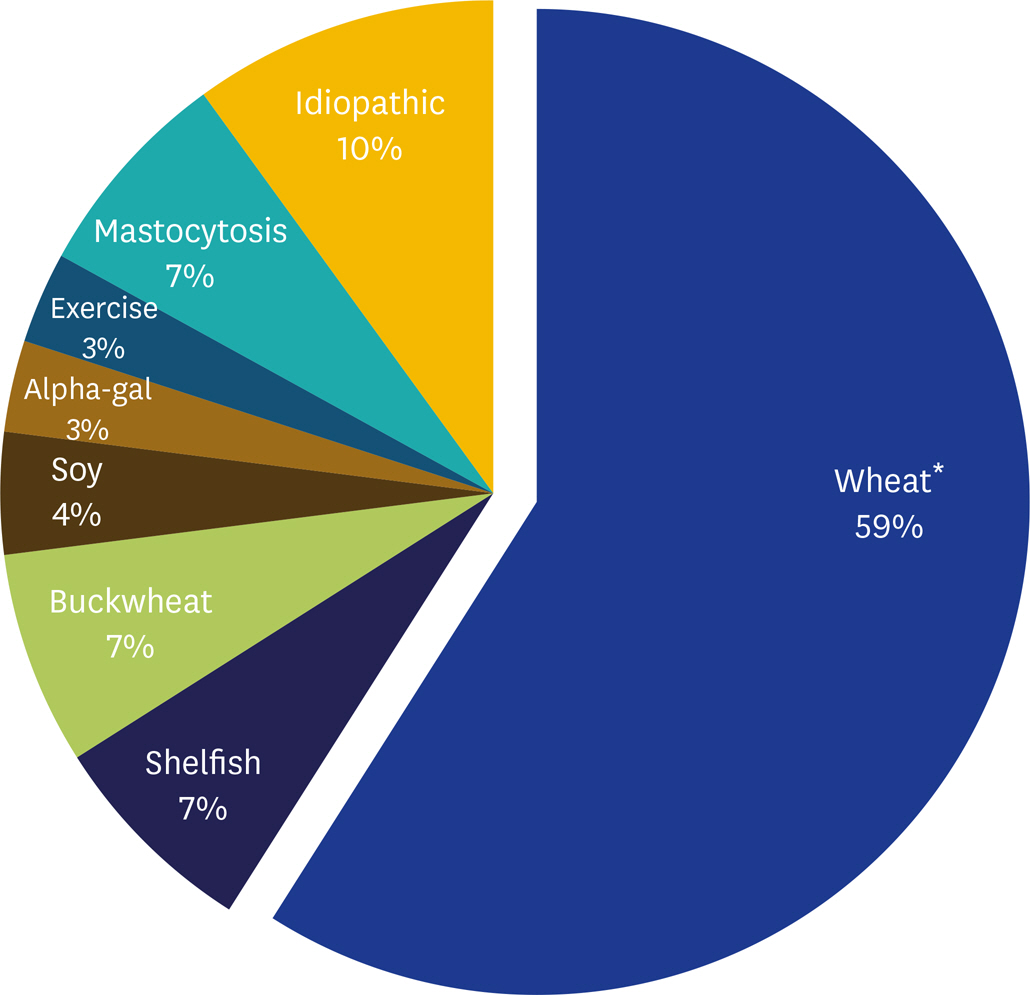Asia Pac Allergy.
2020 Jan;10(1):e5. 10.5415/apallergy.2020.10.e5.
Differences in omega-5-gliadin allergy: East versus West
- Affiliations
-
- 1Division of Rheumatology and Clinical Immunology, Department of Medicine, Queen Mary Hospital, University of Hong Kong, Hong Kong. philipli@connect.hku.hk
- 2Department of Allergy, Guy's and St Thomas' NHS Foundation Trust, London, United Kingdom.
- KMID: 2469858
- DOI: http://doi.org/10.5415/apallergy.2020.10.e5
Abstract
- BACKGROUND
Omega-5-gliadin (O5G) allergy, also known as wheat-dependent exercise-induced anaphylaxis, is commonly reported in the Western, but not Asian, populations. Although significant differences in O5G allergy presentation across different populations are likely but there have been no previous reports on this important topic.
OBJECTIVE
To report on the prevalence and characteristics of O5G allergy in Hong Kong (HK) compared with the United Kingdom (UK).
METHODS
O5G allergy patients attending Queen Mary Hospital (HK cohort), and Guy's and St Thomas' Hospital, London (UK cohort) were studied and compared.
RESULTS
A total of 46 O5G allergy patients (16 HK; 30 UK) were studied. In the HK cohort, 55% of all patients previously labeled as "idiopathic anaphylaxis" were diagnosed with O5G allergy. Exercise was the most common cofactor in both cohorts, followed by alcohol and nonsteroidal anti-inflammatory drugs (NSAID). A higher proportion of the HK cohort reported NSAID as a cofactor (13% vs. 0%, p = 0.048). In the HK cohort, more patients presented with urticaria and cardiovascular manifestations (100% vs. 77%, p = 0.036; 100% vs. 70%, p = 0.015, respectively); the range of presentation was more diverse in the UK cohort. In HK fewer patients adhered to wheat avoidance (50% vs. 87%, p = 0.007) and more patients avoided cofactors only (44% vs. 10%, p = 0.008).
CONCLUSION
O5G allergy appears relatively underdiagnosed in HK. Urticaria and cardiovascular manifestations are common; NSAID plays an important role as a cofactor and patients are less concordant with dietary avoidance measures than in the Western population.
Keyword
MeSH Terms
Figure
Cited by 1 articles
-
The 10th Anniversary of Asia Pacific Allergy
Yoon-Seok Chang
Asia Pac Allergy. 2020;10(1):. doi: 10.5415/apallergy.2020.10.e10.
Reference
-
References
1. Morita E, Kunie K, Matsuo H. Food-dependent exercise-induced anaphylaxis. J Dermatol Sci. 2007; 47:109–17.
Article2. Kennard L, Thomas I, Rutkowski K, Azzu V, Yong PFK, Kasternow B, Hunter H, Cabdi NMO, Nakonechna A, Wagner A. A multicenter evaluation of diagnosis and management of omega-5 gliadin allergy (also known as wheat-dependent exercise-induced anaphylaxis) in 132 adults. J Allergy Clin Immunol Pract. 2018; 6:1892–7.
Article3. Scherf KA, Brockow K, Biedermann T, Koehler P, Wieser H. Wheat-dependent exercise-induced anaphylaxis. Clin Exp Allergy. 2016; 46:10–20.
Article4. Lee TH, Leung TF, Wong G, Ho M, Duque JR, Li PH, Lau CS, Lam WF, Wu A, Chan E, Lai C, Lau YL. The unmet provision of allergy services in Hong Kong impairs capability for allergy prevention-implications for the Asia Pacific region. Asian Pac J Allergy Immunol. 2019; 37:1–8.5. Kushimoto H, Aoki T. Masked type I wheat allergy. Relation to exercise-induced anaphylaxis. Arch Dermatol. 1985; 121:355–60.
Article6. Li PH, Lau CS. Immunology in food allergy and anaphylaxis. Hong Kong Bull Rheum Dis. 2017; 17:26.
Article7. Lee AJ, Thalayasingam M, Lee BW. Food allergy in Asia: how does it compare? Asia Pac Allergy. 2013; 3:3–14.
Article8. Hospital Authority. Hospital Authority annual report 2017-2018 [Internet]. Hong Kong: Hospital Authority;2018. [cited 2019 Dec 9]. Available from:. http://www.ha.org.hk/ho/corpcomm/AR201718/PDF/HA_Annual_Report_2017-2018.pdf.9. Muraro A, Roberts G, Worm M, Bilò MB, Brockow K, Fernández Rivas M, Santos AF, Zolkipli ZQ, Bellou A, Beyer K, Bindslev-Jensen C, Cardona V, Clark AT, Demoly P, Dubois AE, DunnGalvin A, Eigenmann P, Halken S, Harada L, Lack G, Jutel M, Niggemann B, Ruëff F, Timmermans F, Vlieg-Boerstra BJ, Werfel T, Dhami S, Panesar S, Akdis CA, Sheikh A. EAACI Food Allergy and Anaphylaxis Guidelines Group. Anaphylaxis: guidelines from the European Academy of Allergy and Clinical Immunology. Allergy. 2014; 69:1026–45.
Article10. Le TA, Al Kindi M, Tan JA, Smith A, Heddle RJ, Kette FE, Hissaria P, Smith WB. The clinical spectrum of omega-5-gliadin allergy. Intern Med J. 2016; 46:710–6.
Article11. Wölbing F, Fischer J, Köberle M, Kaesler S, Biedermann T. About the role and underlying mechanisms of cofactors in anaphylaxis. Allergy. 2013; 68:1085–92.
Article12. Matsuo H, Morimoto K, Akaki T, Kaneko S, Kusatake K, Kuroda T, Niihara H, Hide M, Morita E. Exercise and aspirin increase levels of circulating gliadin peptides in patients with wheat-dependent exercise-induced anaphylaxis. Clin Exp Allergy. 2005; 35:461–6.
Article13. Christensen MJ, Eller E, Mortz CG, Brockow K, Bindslev-Jensen C. Wheat-dependent cofactor-augmented anaphylaxis: a prospective study of exercise, aspirin, and alcohol efficacy as cofactors. J Allergy Clin Immunol Pract. 2019; 7:114–21.
Article14. Huang WY, Saver JL, Wu YL, Lin CJ, Lee M, Ovbiagele B. Frequency of intracranial hemorrhage with low-dose aspirin in individuals without symptomatic cardiovascular disease: a systematic review and meta-analysis. JAMA Neurol. 2019 May 13. [Epub].https://doi.org/10.1001/jamaneurol.2019.1120.15. Lee CP. Health care system and pharmacy practice in Hong Kong. Can J Hosp Pharm. 2018; 71:140–8.
Article16. Christensen MJ, Eller E, Mortz CG, Brockow K, Bindslev-Jensen C. Exercise lowers threshold and increases severity, but wheat-dependent, exercise-induced anaphylaxis can be elicited at rest. J Allergy Clin Immunol Pract. 2018; 6:514–20.
Article
- Full Text Links
- Actions
-
Cited
- CITED
-
- Close
- Share
- Similar articles
-
- Usefulness of specific IgE antibody levels to wheat, gluten, and ω-5 gliadin for wheat allergy in Korean children
- An unusual case of infant seizures with anaphylaxis to wheat
- Wheat-Induced Anaphylaxis in Korean Adults: A Report of 6 Cases
- Multiple Allergen Simultaneous Test for Food Allergens Cannot Screen Wheat-Dependent, Exercise-Induced Anaphylaxis and α-Gal Syndrome
- A Case of Gluten Allergy in a 4-Year-Old Boy With Recurrent Urticaria




